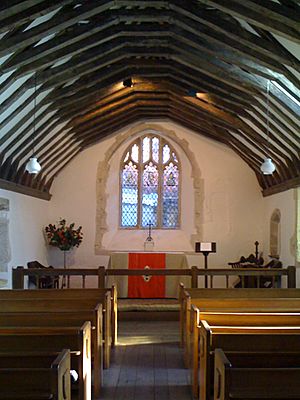St Swithun-upon-Kingsgate Church facts for kids
Quick facts for kids St Swithun upon Kingsgate |
|
|---|---|

St Swithun upon Kingsgate
|
|
| 51°3′33″N 1°18′52″W / 51.05917°N 1.31444°W | |
| Location | Kingsgate, Winchester |
| Country | United Kingdom |
| Denomination | Church of England |
| Architecture | |
| Style | Early English |
| Years built | Thirteenth Century |
| Administration | |
| Parish | St Lawrence with St Swithun |
St Swithun upon Kingsgate is a Church of England church located in Winchester, Hampshire, England. It was built a long time ago, during the Middle Ages, in a style called Early English.
What makes this church special is its location. It sits right above the medieval Kingsgate, which was one of the main entrances into the city. This means the church is actually part of the old city walls! People first wrote about St Swithun's in the 1200s. It even appears in a famous book, The Warden by Anthony Trollope, though he called it "St Cuthbert's" in his story.
Contents
History of the Church
How the Church Began
We don't have any records that say exactly when the church was built. However, we know it existed by 1264. That year, there was a big uprising in Winchester. Buildings were burned, including "Kingsgate with the church of St Swithun above." This tells us the church was already there, sitting on top of the gate.
The church probably served as a small chapel for ordinary people who worked for the nearby Abbey. In 1337, some wood repairs were done. Later, in 1484, the windows were fixed.
Who Was St Swithun?
St Swithun was an Anglo-Saxon saint. He was born in Winchester and became the city's 19th bishop in 852. He passed away in 862, when King Alfred the Great was still a young man. Some people believe St Swithun might have been King Alfred's teacher. He might have even gone with the young king on a trip to Rome.
There's a famous legend about St Swithun and the English weather. It started in July 971. That's when the saint's bones were moved from outside the old Saxon cathedral to inside. Legend says this caused a huge thunderstorm! This led to the well-known rhyme:
- On St Swithun's Day, if then dost rain,
- For forty days it will remain:
- St Swithun's Day, if then be fair,
- For forty days 'twill rain nae mair.
St Swithun's Day is celebrated every year on July 15th.
Changes During the Reformation
In 1538, during a time called the Reformation, the special shrine of St Swithun in Winchester Cathedral was destroyed. The monastery there was also closed down in 1539. Because of these changes, St Swithun upon Kingsgate became a regular parish church. The empty space on the East wall probably once held a statue of St Swithun. This statue was likely removed or destroyed around this time.
By the 1600s, the church was in bad shape. It was even used as a home by a gatekeeper and his wife, who kept pigs nearby! But around 1660, the church was fixed up. Its bells were re-hung in 1677. Since then, it has always been a place for worship.
The Church in Books
St Swithun's church appears in Anthony Trollope's book The Warden. In the story, a character named Warden Harding becomes the Rector of "St Cuthbert's." This is really St Swithun's church, just with a different name. Trollope wrote about the church in the 1850s. He described it as a "singular little Gothic building, perched over a gateway." He said it was "no bigger than an ordinary room."
While Trollope's description is close, there are a few small differences. The church's staircase is made of wood, not stone. Also, the church is over Kingsgate itself, not the nearby gateway to the Close.
The Church Today
Today, Kingsgate is a scheduled monument, which means it's a very important historical site. The city of Winchester takes care of the gate. The church, which is a grade I listed building, is looked after by the local church parish.
In 1960, a 17th-century altar rail from a Winchester school was put into the church. The east window has some old pieces of stained glass from the Middle Ages. These pieces probably show the Annunciation, which is when the Angel Gabriel told Mary she would have Jesus. These glass pieces were moved to St Swithun's in 1961 from St Peter's Church, Chesil. In 1968, a church member named Colin Campbell built new pews, which are the seats you see in the church today.
You can get into the church by a staircase. Parts of this staircase are from the 1500s, with newer steps added in 1954. The entrance is on St Swithun Street, next to the right-hand arch of Kingsgate.
Lord Coggan, who used to be the Archbishop of Canterbury, often attended this church after he retired. He sometimes even played the piano during services! His funeral was held at St Swithun's on May 26, 2000. His initials are carved on a bench-end in the church to remember him.
Gallery
-
A memorial for William Henry Laverty, a church member who died in World War I.





